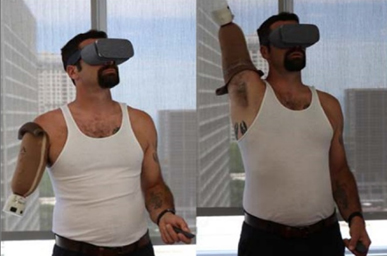A Virtual Reality System to Treat Phantom Limb Pain
Body
Limb loss can cause chronic pain, including the formation of painful neuromas and phantom limb pain (PLP) where ongoing painful sensations in the area of the missing limb can persist. While any type of pain can be debilitating, the exact mechanisms of PLP are less understood, and as a result, current treatment options are limited and have been mostly ineffective.
Some recent research suggests that targeted muscle reinnervation, a surgical nerve transfer procedure, can prevent neuroma formation and PLP in some amputees if performed at the time of amputation. In addition, noninvasive and non-pharmacological forms of treatment, such as mirror therapy, has shown some promise for reducing PLP. However, one disadvantage of mirror therapy is that it is unclear if the user is intending to execute the motor commands with their phantom limb, or if they are just watching the image of their intact limb move. Advancements in pattern recognition systems that can decipher electromyographic (EMG) signal patterns generated by the residual limb muscles invites new opportunities to enhance treatment of PLP beyond basic mirror therapy.
Recent studies suggest that using pattern recognition to control a virtual limb may have similar therapeutic benefits. The Shirley Ryan AbilityLab recently developed a virtual reality-based (VR), rehabilitation system for individuals with upper limb amputation which consists of:
- A gel-liner system with embedded electrodes for EMG signal acquisition
- A Coapt, LLC Gen 2 pattern recognition system
- A virtual gaming software for 2D or 3D rendering
In previous work, we showed that the VR system can be used as a rehabilitation training device to improve prosthetic control, as well as provided encouraging evidence of its multi-functional utility in providing relief from PLP.
Goals and Hypothesis
Body

This project builds upon our prior work to further test our VR system for individuals with lower limb amputation and to evaluate its potential for PLP therapy in a larger trial. We will develop a commercially viable VR rehabilitation system (called the Coapt PLP Management System) which can be deployed at home or in-clinic for individuals with upper or lower limb amputations. Our hypothesis is that long-term use of the VR system will significantly reduce PLP.
Lead Study Personnel
Body
Levi Hargrove, PhD, Co-Principal Investigator
Blair Lock, CEO, Coapt, Co-Principal Investigator
Mentioned Profile

Levi Hargrove, PhD
Scientific Chair, The Regenstein Foundation Center for Bionic Medicine Director, Neural Engineering for Prosthetics and Orthotics LabRelated Publications & Patents
Body
Hargrove LJ, Woodward RB, inventors; Rehabilitation Institute of Chicago, assignee. Prosthetic virtual reality training interface and related methods. United States patent US 10,796,599. 2020 Oct 6.
Woodward RB, Hargrove LJ. Adapting myoelectric control in real-time using a virtual environment. Journal of neuroengineering and rehabilitation. 2019 Dec 1;16(1):11.
Funding Source
Body
Restoring Warfighters with Neuromusculoskeletal Injuries Research Award (RESTORE), Department of Defense
